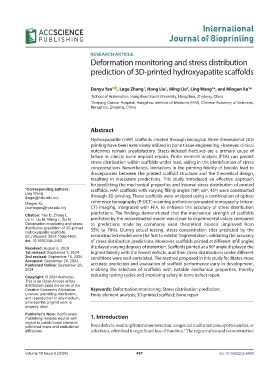Page 465 - IJB-10-6
P. 465
International
Journal of Bioprinting
RESEARCH ARTICLE
Deformation monitoring and stress distribution
prediction of 3D-printed hydroxyapatite scaffolds
Danyu Yao 1 id , Luge Zhang , Hong Liu , Ming Liu , Ling Wang *, and Mingen Xu *
2
1
1
1
1
1 School of Automation, Hangzhou Dianzi University, Hangzhou, Zhejiang, China
2 Zhejiang Cancer Hospital, Hangzhou Institute of Medicine (HIM), Chinese Academy of Sciences,
Hangzhou, Zhejiang, China
Abstract
Hydroxyapatite (HAP) scaffolds created through biological three-dimensional (3D)
printing have been extensively utilized in bone tissue engineering. However, clinical
outcomes remain unsatisfactory. Stress-induced fractures are a primary cause of
failure in clinical bone implant repairs. Finite element analysis (FEA) can predict
stress distribution within scaffolds under load, aiding in the identification of stress
concentrations. Nevertheless, limitations in the printing fidelity of bioinks lead to
discrepancies between the printed scaffold structure and the theoretical design,
resulting in inaccurate predictions. This study introduced an effective approach
for predicting the mechanical properties and internal stress distribution of printed
*Corresponding authors: scaffolds. HAP scaffolds with varying filling angles (90º, 60º, 45º) were constructed
Ling Wang
(lingw@hdu.edu.cn) through 3D printing. These scaffolds were analyzed using a combination of optical
Mingen Xu coherence tomography (P-OCT) scanning and micro-computed tomography (micro-
(xumingen@hdu.edu.cn) CT) imaging, integrated with FEA, to enhance the accuracy of stress distribution
predictions. The findings demonstrated that the mechanical strength of scaffolds
Citation: Yao D, Zhang L,
Liu H, Liu M, Wang L, Xu M. predicted by the reconstructed model was closer to experimental values compared
Deformation monitoring and stress to predictions made by commonly used theoretical models (improved from
distribution prediction of 3D-printed 55% to 78%). During actual testing, stress concentration sites predicted by the
hydroxyapatite scaffolds.
Int J Bioprint. 2024;10(6):4460. reconstructed model were the first to exhibit fragmentation, validating the accuracy
doi: 10.36922/ijb.4460 of stress distribution predictions. Moreover, scaffolds printed at different infill angles
Received: August 6, 2024 displayed varying degrees of distortion. Scaffolds printed at a 90º angle displayed the
1st revised: September 3, 2024 highest fidelity with the fewest defects, and their stress distributions under different
2nd revised: September 18, 2024 conditions were well-correlated. The method proposed in this study facilitates more
Accepted: September 26, 2024
Published Online: September 26, accurate prediction and evaluation of scaffold performance early in development,
2024 enabling the selection of scaffolds with suitable mechanical properties, thereby
Copyright: © 2024 Author(s). reducing testing cycles and improving safety in bone defect repair.
This is an Open Access article
distributed under the terms of the
Creative Commons Attribution Keywords: Deformation monitoring; Stress distribution prediction;
License, permitting distribution, Finite element analysis; 3D printed scaffold; Bone repair
and reproduction in any medium,
provided the original work is
properly cited.
Publisher’s Note: AccScience
Publishing remains neutral with 1. Introduction
regard to jurisdictional claims in
published maps and institutional Bone defects, resulting from tumor resection, congenital malformations, sports injuries, or
1
affiliations. infections, often lead to significant loss of function. The regeneration and reconstruction
Volume 10 Issue 6 (2024) 457 doi: 10.36922/ijb.4460

